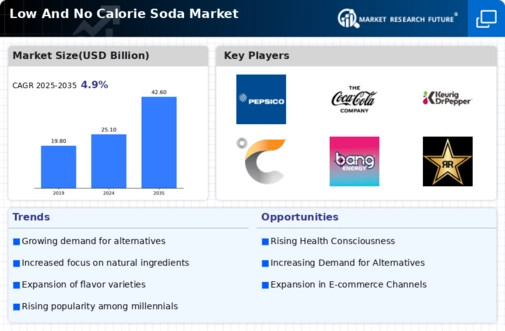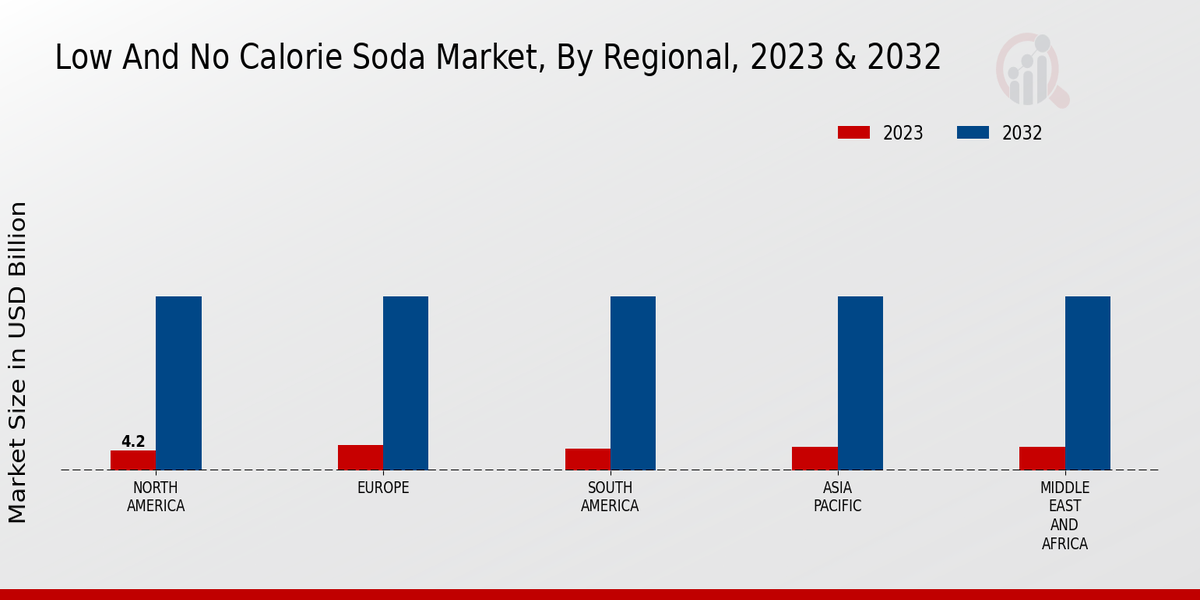Product Innovation
Innovation in product formulations significantly influences the Global Low And No Calorie Soda Market Industry. Manufacturers are continuously developing new flavors, sweeteners, and packaging solutions to attract a broader consumer base. For instance, the introduction of natural sweeteners and unique flavor combinations has garnered attention from health-conscious consumers. This trend is likely to contribute to the market's growth, with projections indicating a rise to 42.6 USD Billion by 2035. The emphasis on creating appealing and diverse product lines suggests that companies are adapting to changing consumer preferences, which may enhance their competitive edge in the market.
Regulatory Support
Government regulations promoting healthier beverage options play a crucial role in shaping the Global Low And No Calorie Soda Market Industry. Many countries are implementing policies aimed at reducing sugar consumption, which encourages manufacturers to innovate and offer low and no calorie alternatives. This regulatory environment not only supports public health initiatives but also creates a favorable market landscape for low calorie products. As a result, the industry is likely to experience growth, with a projected compound annual growth rate of 4.92% from 2025 to 2035. Such supportive measures may further enhance consumer acceptance and drive market expansion.
Health Consciousness
The increasing awareness of health and wellness among consumers drives the Global Low And No Calorie Soda Market Industry. As individuals become more conscious of their dietary choices, they tend to seek alternatives to traditional sugary beverages. This trend is reflected in the projected market value of 25.1 USD Billion in 2024, indicating a robust demand for low and no calorie options. Consumers are increasingly opting for products that align with their health goals, leading to a rise in the availability of innovative formulations that cater to this demographic. The industry's response to this shift suggests a potential for sustained growth in the coming years.
Sustainability Trends
The rising focus on sustainability and environmental responsibility influences the Global Low And No Calorie Soda Market Industry. Consumers are becoming more aware of the environmental impact of their purchases, prompting manufacturers to adopt sustainable practices in production and packaging. This trend is reflected in the increasing demand for eco-friendly packaging solutions and natural ingredients in low calorie sodas. As sustainability becomes a key consideration for consumers, the industry is likely to see growth, with projections indicating a market value of 42.6 USD Billion by 2035. Companies that prioritize sustainability may find themselves better positioned to capture the attention of environmentally conscious consumers.
Market Growth Projections
The Global Low And No Calorie Soda Market Industry is poised for substantial growth, with projections indicating a market value of 25.1 USD Billion in 2024 and an anticipated increase to 42.6 USD Billion by 2035. This growth trajectory suggests a compound annual growth rate of 4.92% from 2025 to 2035. Such figures reflect the increasing consumer demand for healthier beverage options, as well as the industry's responsiveness to evolving market dynamics. The potential for expansion within this sector highlights the importance of innovation and adaptability among manufacturers as they seek to capitalize on emerging trends.
Changing Consumer Preferences
The evolving preferences of consumers towards low and no calorie beverages significantly impact the Global Low And No Calorie Soda Market Industry. With a growing emphasis on healthier lifestyles, consumers are increasingly inclined to choose beverages that offer taste without the added calories. This shift is evident in the rising demand for low calorie sodas, which is expected to contribute to the market's valuation of 25.1 USD Billion in 2024. The industry's ability to adapt to these changing preferences indicates a potential for sustained growth, as manufacturers strive to meet the expectations of a more health-conscious consumer base.



















Leave a Comment